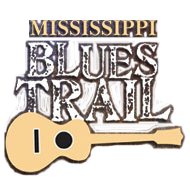Rubin Lacy
Rubin Lacy - Pelahatchie
Rubin Lacy was one of the most talented and influential artists in Mississippi blues during his short career as a secular performer. The grandson of a minister, Lacy was born in Pelahatchie on January 2, 1901, or 1902*. He was a well-known blues performer in the Jackson area and the Delta until he became a preacher in the 1930s. He pastored churches in Mississippi, Arkansas, Missouri and California and was still preaching when he died on November 14, 1969.
* His birthdate was given on his death certificate as Jan. 2, 1902, although blues scholar David Evans believed it to be 1901.)
Rubin “Rube” Lacy recorded only a handful of blues songs, but he played an important role in the formative years of Mississippi blues. Lacy learned guitar and mandolin by emulating George “Crow Jane” Hendrix, who led a local string band. As a young man Lacy traveled widely, and he recalled meeting country music pioneer Jimmie Rodgers while both were railway workers, and working in Chicago with an uncle from Germany who taught Lacy to speak German fluently. After returning to the Jackson area, where he became known as the “blues king,” Lacy played in an elite circle that included Son Spand, Ishmon Bracey, Tommy Johnson, Charlie McCoy, and Walter Vinson. He later moved to the Delta, where he formed his own group, performed with Charley Patton, and inspired Son House, Tommy McClennan, and Honeyboy Edwards.
Lacy made four recordings for Columbia Records at a session in Memphis in December 1927, but none were released. The following March he traveled to Chicago, where he recorded two songs for the Paramount label, “Mississippi Jail House Groan” and “Ham Hound Crave,” both of which he learned from Hendrix. Accompanying Lacy on the trip was music talent agent Ralph Lembo of Itta Bena, who contributed a spoken part to “Ham Hound Crave.” The two Paramount tracks, the only blues recordings by Lacy that were ever released, are considered such prime examples of Mississippi blues that both songs have appeared on numerous reissue CDs and LPs around the world.
Following a train-related injury in the 1930s, Lacy decided to join the ministry, a path followed at times by several Mississippi bluesmen of his generation. Lacy preached in Mississippi, Arkansas, and Missouri before moving to California. In 1966 blues scholar David Evans located Lacy in Ridgecrest, California, and recorded him preaching and performing gospel songs with members of his congregation. Although Lacy would no longer perform blues, he remained proud of his early recordings and suggested to Evans that the religiously devout feel the blues “quicker than a sinner do, ’cause the average sinner ain’t got nothing to worry about.” A newspaper obituary and Lacy’s death certificate in 1969 both gave Pelahatchie as his burial site—as cited on the front of this marker—but his son, gospel singer Rev. John Lacy of Indianapolis, has since reported that his family decided to bury him instead in Bakersfield, California.
Blues performers born in Rankin County, in addition to Lacy, included Luther and Percy Huff, Shirley Griffith, John Henry “Bubba” Brown, Tommy Lee Thompson, Othar Turner, Jessie “Little Howlin’ Wolf” Sanders, and Pelahatchie native Leroy “Lefty” Bates. Griffith, Bates, and some of Lacy’s children who sang R&B or gospel later moved to Indianapolis, Indiana.
content © Mississippi Blues Commission
[ BACK TO TOP ]

